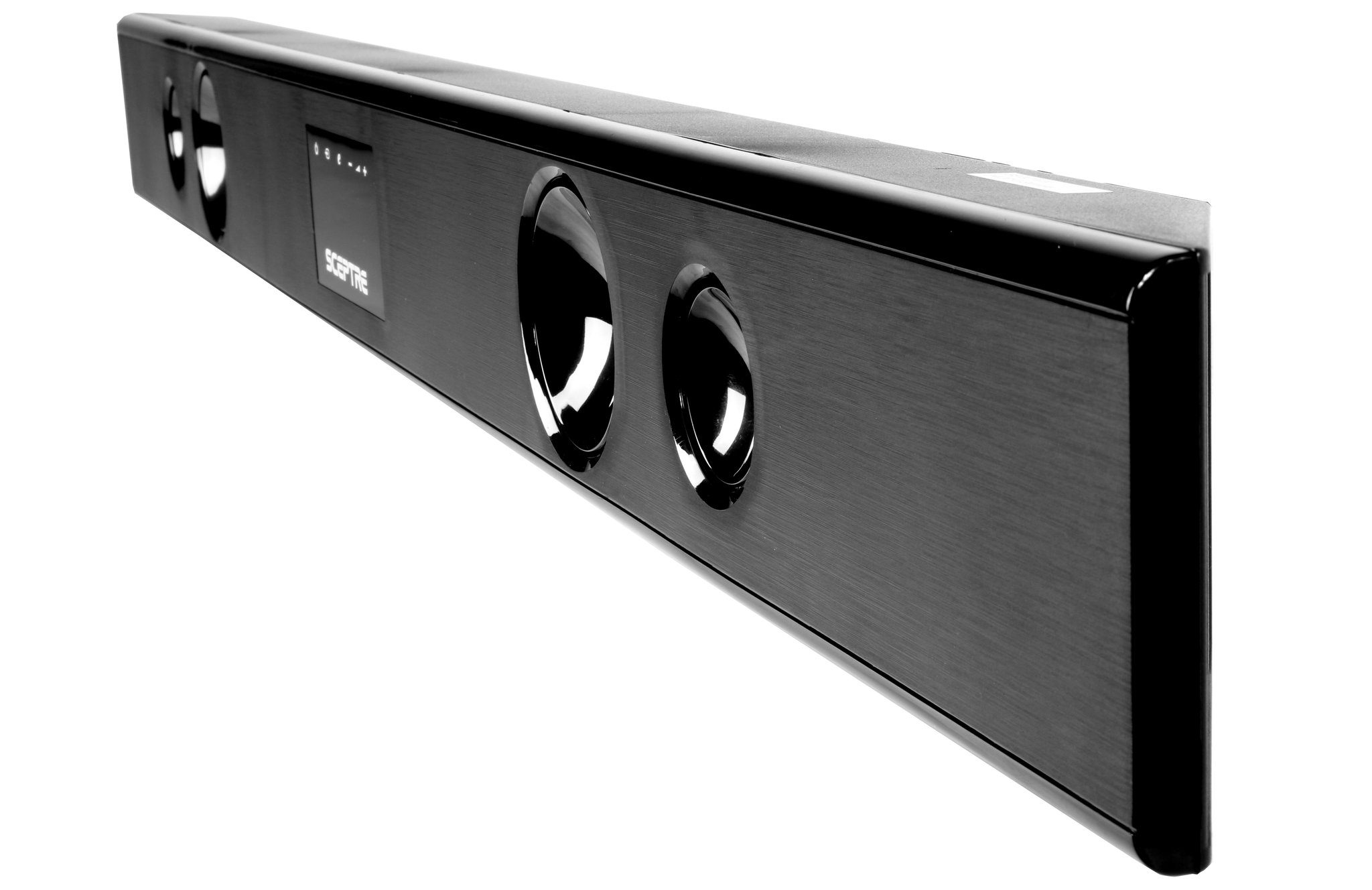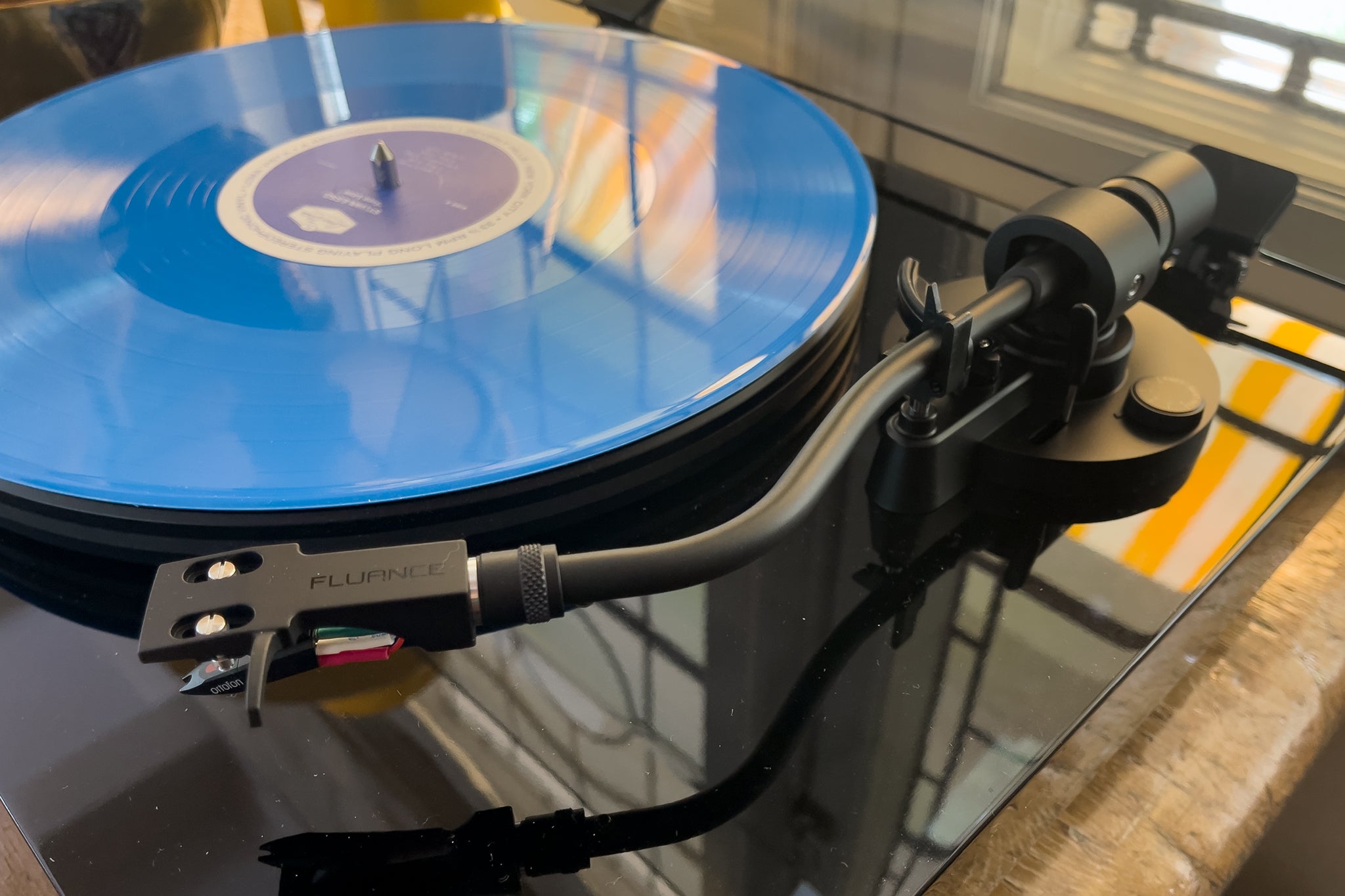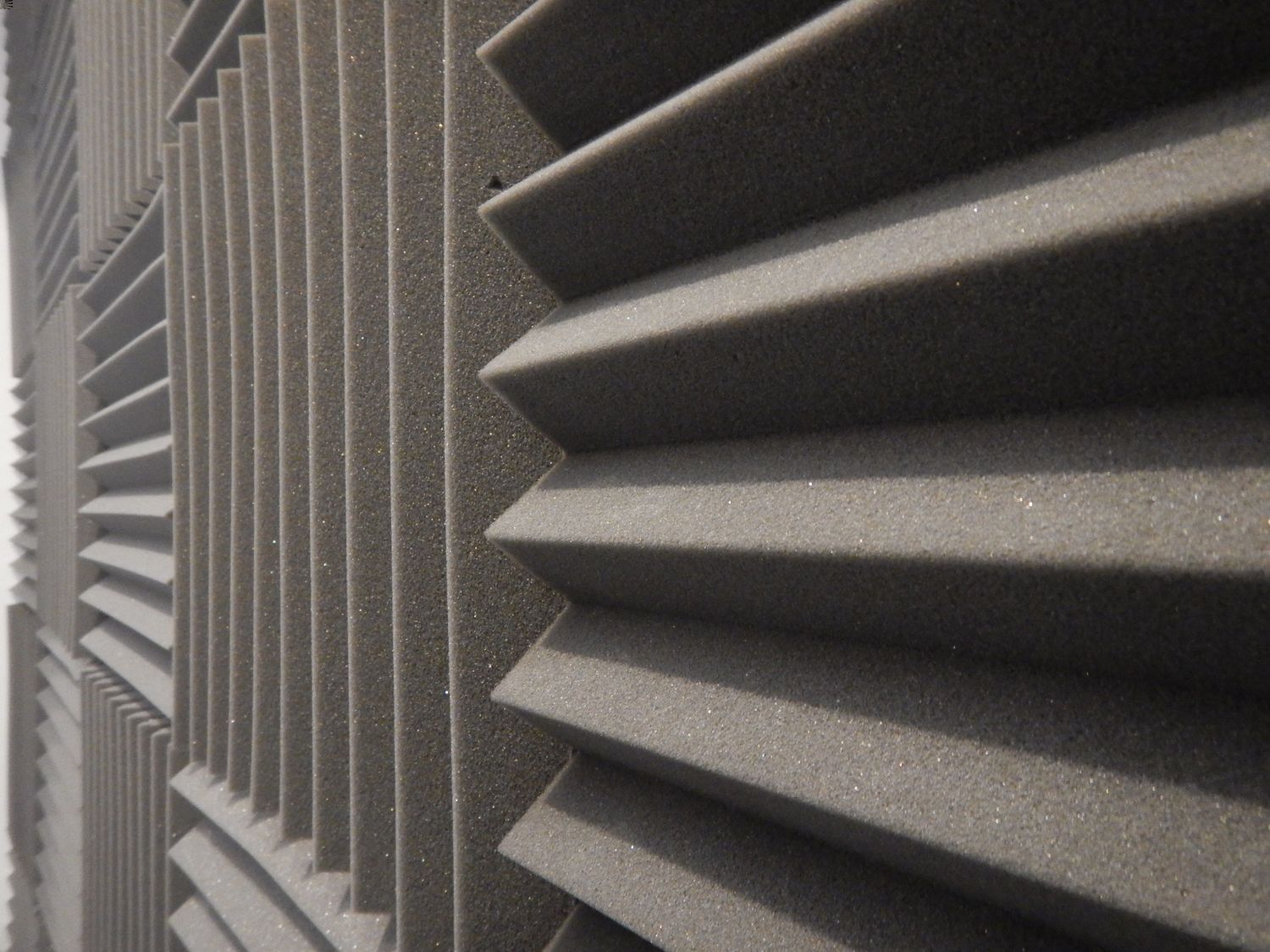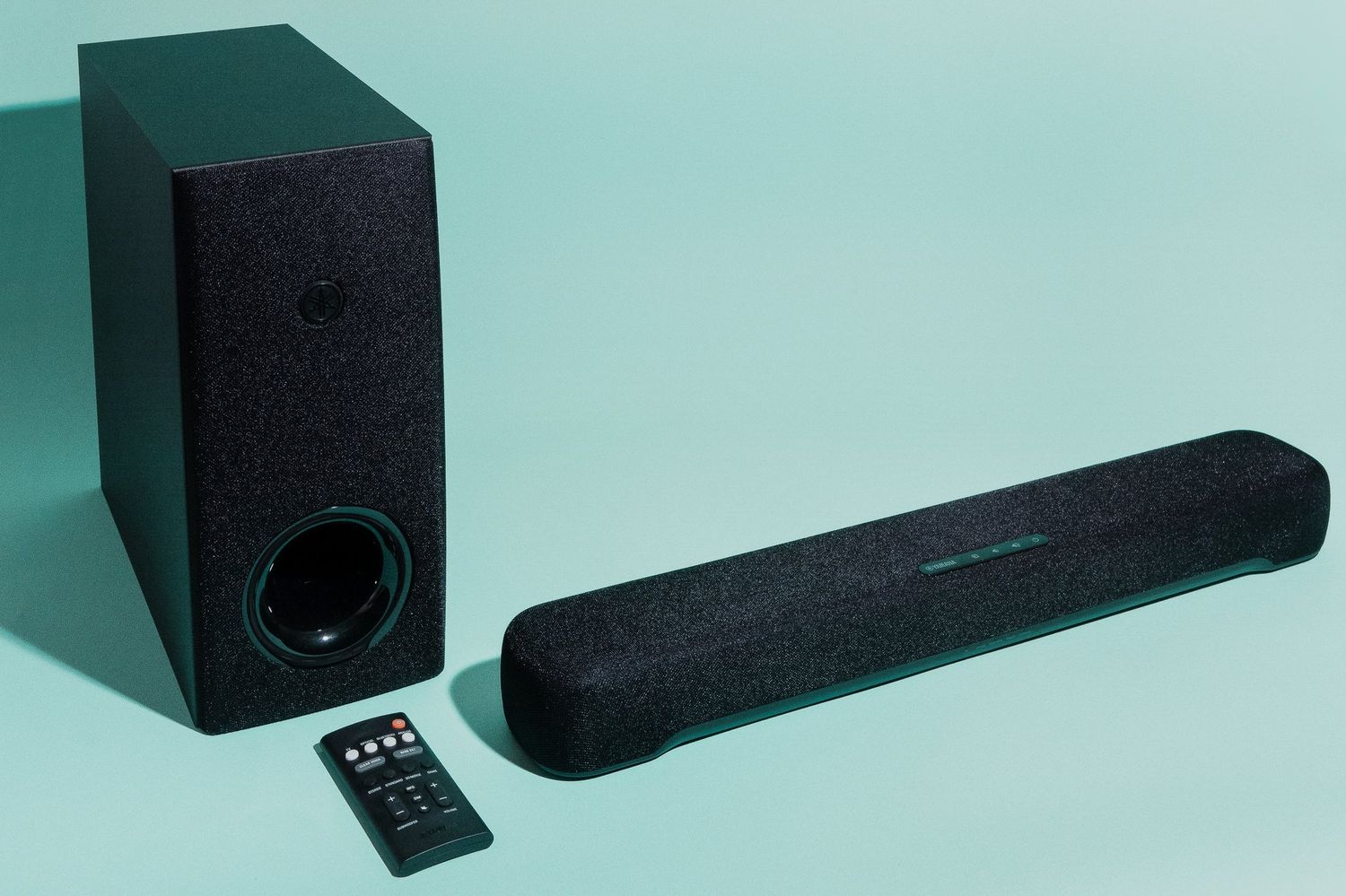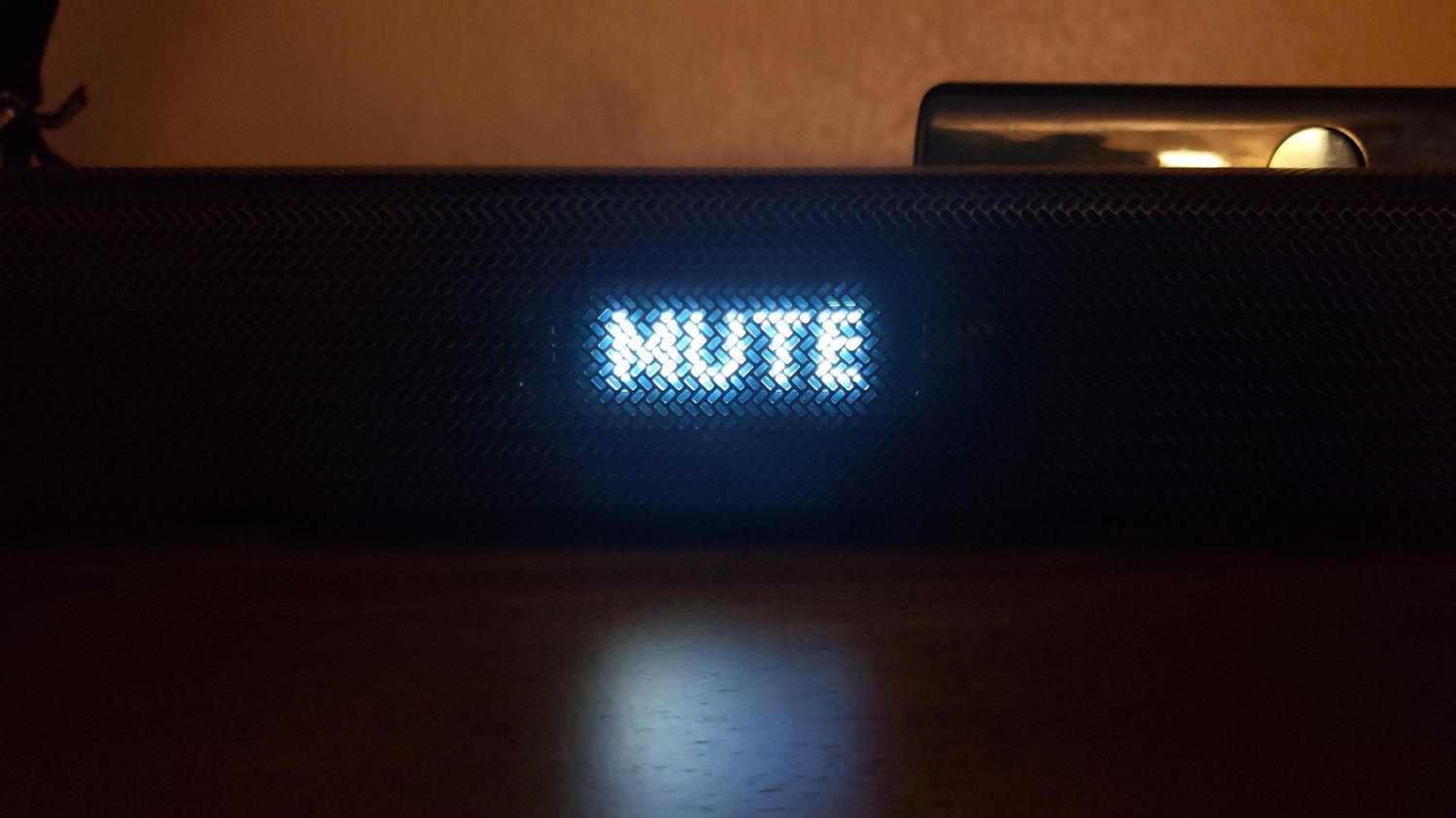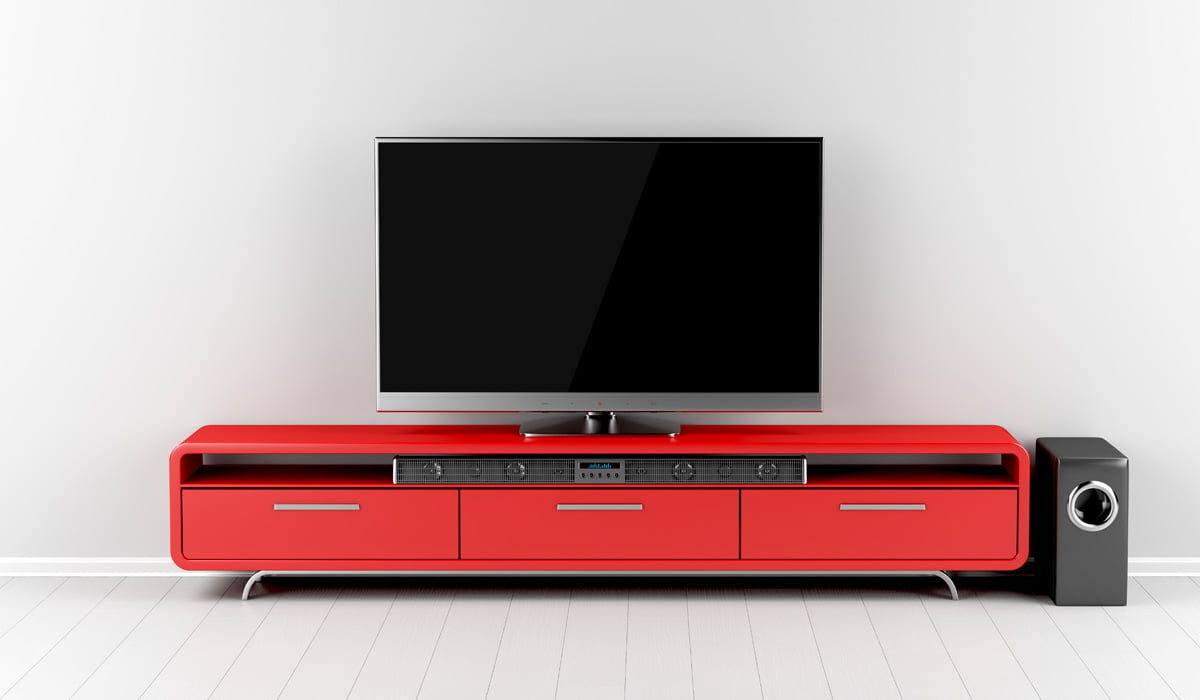Home>Production & Technology>Sound Bar>How Does A Passive Sound Bar Work


Sound Bar
How Does A Passive Sound Bar Work
Modified: February 18, 2024
Discover how a sound bar works and enhances your audio experience with its passive design.
(Many of the links in this article redirect to a specific reviewed product. Your purchase of these products through affiliate links helps to generate commission for AudioLover.com, at no extra cost. Learn more)
Table of Contents
Introduction
Welcome to the world of soundbars, where audio technology meets simplicity and style. Whether you are a movie enthusiast, a gaming aficionado, or a lover of music, a soundbar can greatly enhance your audio experience. But what exactly is a soundbar, and how does it work?
A soundbar is a slim, elongated speaker system that is designed to provide high-quality audio while maintaining a sleek and minimalistic appearance. Unlike traditional speaker setups that involve multiple speakers and wires, a soundbar offers a streamlined solution that takes up minimal space and requires minimal setup. Among the various types of soundbars available, one popular option is the passive soundbar.
So, what sets a passive soundbar apart from its counterparts? Unlike active soundbars that have built-in amplifiers and require a power source, a passive soundbar relies on an external amplifier or receiver to provide the necessary power. This makes it a flexible choice that can be integrated into existing home theater setups or customized to suit individual preferences.
In this article, we will delve into the world of passive soundbars and explore how they work. We will discuss the different components that make up a passive soundbar, including speaker drivers, crossovers, and enclosure design. Additionally, we will explore the various connection options available for a passive soundbar. By the end of this article, you will have a comprehensive understanding of how a passive soundbar operates and its pros and cons.
So, whether you are considering purchasing a passive soundbar or simply curious about how these audio devices function, join us as we unravel the mysteries behind the immersive and captivating audio experience provided by passive soundbars.
What is a passive soundbar?
A passive soundbar is a type of soundbar that requires an external amplifier or receiver to function. Unlike active soundbars, which have built-in amplifiers, passive soundbars rely on an external power source to deliver audio. This makes them a versatile option that can be integrated into existing audio systems or customized to suit individual preferences.
A passive soundbar typically consists of multiple speaker drivers housed in a sleek and compact enclosure. These speaker drivers are responsible for reproducing sound across different frequencies, ensuring a well-balanced and immersive audio experience. The enclosure design is meticulously engineered to maximize sound dispersion, resulting in a wider soundstage and improved audio clarity.
One of the key advantages of a passive soundbar is its flexibility in terms of amplifier choice. With an external amplifier or receiver, users have the freedom to select the preferred audio setup that best suits their needs. This allows for customization and optimization of the audio performance, whether it’s optimizing for home theater applications or specifically catering to personal audio preferences.
When it comes to connectivity options, passive soundbars typically offer a range of input and output ports to accommodate various audio sources. Common connection options include speaker wire terminals, HDMI inputs, optical inputs, and sometimes even wireless connectivity options like Bluetooth or Wi-Fi. This ensures compatibility with a wide range of devices, such as TVs, gaming consoles, Blu-ray players, and streaming devices.
Another aspect to consider with passive soundbars is the crossover system. A crossover is an electronic circuit that divides the audio signal into different frequency ranges and directs it to the appropriate speaker drivers. This ensures that each driver reproduces sound within its optimal frequency range, resulting in accurate and detailed audio reproduction. The quality and design of the crossover system play a crucial role in creating a seamless and immersive listening experience.
Overall, a passive soundbar offers a balance between performance and customization. Its reliance on an external amplifier or receiver provides the flexibility to tailor the audio setup to specific preferences and existing audio systems. So, whether you are looking to upgrade your home theater setup or enhance your audio experience, a passive soundbar can be a fantastic option to explore.
Components of a passive soundbar
A passive soundbar is composed of several key components that work together to deliver high-quality audio performance. Understanding these components will give you a better appreciation of how a passive soundbar functions and the impact they have on the overall sound quality. Let’s take a closer look at each of these components:
1. Speaker drivers: The speaker drivers are the heart of a passive soundbar. They are responsible for producing the sound and consist of woofers for low frequencies and tweeters for high frequencies. Some soundbars may also include mid-range drivers for better vocal clarity. The number and size of the speaker drivers may vary depending on the specific soundbar model, but the aim is to provide a well-balanced sound output across the entire frequency spectrum.
2. Crossovers: Crossovers are electronic circuits that divide the audio signal into different frequency ranges and send each range to the appropriate speaker drivers. They ensure that each driver operates within its optimal frequency range, resulting in more accurate and detailed sound reproduction. The quality of the crossovers and their design play a significant role in maintaining a balanced audio output and a seamless transition between frequencies.
3. Enclosure design: The enclosure of a passive soundbar is designed to house and optimize the performance of the speaker drivers. The shape, size, and materials used in the enclosure greatly influence the sound quality and overall listening experience. A well-designed enclosure minimizes resonances and unwanted vibrations, allowing the soundbar to deliver cleaner and more accurate sound reproduction. Some soundbars may also incorporate additional technologies like bass ports or passive radiators to enhance low-frequency performance.
4. Connection options: Passive soundbars offer a variety of connection options to accommodate different audio sources and audio systems. Common connection options include speaker wire terminals, HDMI inputs, optical inputs, and sometimes even wireless connectivity like Bluetooth or Wi-Fi. These connection options ensure compatibility with a wide range of devices such as TVs, gaming consoles, streaming devices, and more.
5. Mounting options: Many passive soundbars come with mounting options that allow for easy installation and integration into your home theater setup. These mounting options may include wall-mount brackets or tabletop stands, providing flexibility in positioning the soundbar to achieve the best sound dispersion and optimal listening experience.
By understanding the various components of a passive soundbar, you can make more informed choices when selecting a soundbar that meets your audio needs and preferences. Each component plays an essential role in delivering immersive and high-quality sound, ensuring an enjoyable audio experience for movies, music, and gaming.
Speaker drivers
Speaker drivers are the fundamental components of a passive soundbar responsible for reproducing sound across different frequency ranges. They play a crucial role in delivering clear, balanced, and immersive audio. Understanding the different types of speaker drivers and their functions can help you choose a passive soundbar that suits your audio preferences and provides an enhanced listening experience.
The two primary types of speaker drivers found in a passive soundbar are woofers and tweeters. Woofers are responsible for handling low-frequency sounds, typically below 200Hz. They provide the depth and impact for bass-heavy content like explosions in movies or the thumping beat in music. These drivers tend to be larger in size, allowing them to move more air and produce lower frequencies effectively.
Tweeters, on the other hand, are designed to reproduce high-frequency sounds above 2kHz. They are responsible for capturing the nuances in vocals, instruments, and sound effects that occur in higher frequency ranges. Tweeters are typically smaller in size and can handle the fast vibrations required for accurate high-frequency reproduction.
Some passive soundbars may also include mid-range drivers, which handle frequencies between the woofers and tweeters, typically ranging from 200Hz to 2kHz. Mid-range drivers help to improve the clarity and detail of voices and instruments, ensuring a well-balanced sound reproduction. They are essential for maintaining accurate sound imaging and creating a lifelike audio experience.
The number and arrangement of speaker drivers can vary depending on the design and size of the passive soundbar. Soundbars may feature a two-way design with a combination of woofers and tweeters, or a three-way design with woofers, mid-range drivers, and tweeters. The inclusion of multiple drivers helps to distribute the audio frequencies more precisely, resulting in a more immersive soundstage.
In addition to the types of drivers, the quality of the drivers also impacts the sound reproduction. High-quality drivers made from materials such as polypropylene, kevlar, or composite cones offer better stiffness and less distortion, resulting in more accurate sound reproduction. Some soundbars may also implement advanced driver technologies like neodymium magnets or silk dome tweeters, which further enhance the audio performance.
When considering a passive soundbar, it’s important to evaluate the specifications and capabilities of the speaker drivers. Look for information such as the frequency response range, power handling, and sensitivity to get an idea of the soundbar’s performance. Also, keep in mind that a soundbar with larger drivers and more drivers generally delivers a more powerful and immersive audio experience.
Overall, the speaker drivers in a passive soundbar are responsible for translating audio signals into sound waves. The combination of woofers, tweeters, and potentially mid-range drivers work together to create a well-balanced and immersive listening experience. So, whether you are watching your favorite movie or enjoying a music concert, the quality of the speaker drivers plays a significant role in delivering rich and dynamic sound.
Crossovers
Crossovers are crucial components in a passive soundbar that ensure the accurate distribution of audio signals to the appropriate speaker drivers. They play a vital role in maintaining a balanced sound reproduction and a seamless transition between frequencies. Understanding how crossovers work can help you appreciate the intricate engineering behind a passive soundbar and the impact it has on the overall audio performance.
A crossover is an electronic circuit that divides the audio signal into different frequency ranges and directs each frequency range to the corresponding speaker drivers – woofers, mid-range drivers, and tweeters. By doing so, the crossover ensures that each speaker driver operates within its optimal frequency range, preventing distortion and maximizing sound quality.
There are two main types of crossovers: passive crossovers and active crossovers. Passive crossovers are commonly used in passive soundbars and are placed between the amplifier or receiver and the speaker drivers. They use passive components such as capacitors, inductors, and resistors to filter and redirect specific frequencies. Active crossovers, on the other hand, are typically found in active soundbars and are powered by their own amplifier.
The crossover frequency is a critical parameter that determines at what point the audio signal is divided between the different speaker drivers. This frequency is typically set based on the characteristics and capabilities of the speaker drivers. The goal is to achieve a smooth transition between the different drivers, ensuring that no frequency range is overrepresented or underrepresented.
The quality and design of the crossover circuitry can significantly impact the audio performance of a passive soundbar. Components with higher precision and better tolerance help maintain signal integrity and accuracy. Additionally, well-designed crossovers incorporate slopes that control the rate at which frequencies are attenuated or boosted as they transition between drivers. Common types of slopes include 6dB/octave, 12dB/octave, and 24dB/octave.
Another essential aspect to consider is the phase response of the crossover. Phase response refers to how the crossover affects the timing of audio signals. An ideal crossover would have a linear phase response, maintaining the synchronization between the different frequencies and avoiding any phase shifts that can negatively impact the audio quality.
By carefully selecting and fine-tuning the crossover components and settings, engineers can ensure a seamless integration of the various speaker drivers in a passive soundbar. This results in a cohesive and natural sound reproduction, with each driver handling its designated frequency range without interference or distortion.
To sum it up, crossovers are integral to the performance of a passive soundbar as they divide and direct the audio signals to the appropriate speaker drivers. They help maintain a balanced and accurate audio output, ensuring that each driver operates within its optimal frequency range. With precise component selection and careful design, crossovers contribute to a seamless transition between frequencies and a satisfying listening experience.
Enclosure design
The enclosure design of a passive soundbar is a critical factor that significantly impacts the performance and sound quality of the audio system. The shape, size, construction materials, and internal structure of the enclosure are carefully engineered to maximize sound dispersion, minimize resonance, and deliver a clear and immersive listening experience.
The primary purpose of the enclosure is to house and support the speaker drivers while providing an environment that allows them to perform optimally. A well-designed enclosure helps prevent the interaction of sound waves from the front and rear of the drivers, reducing distortion and improving overall sound accuracy.
The shape and dimensions of the enclosure play a crucial role in determining the sound dispersion and imaging. A passive soundbar may adopt various enclosure designs, including sealed, ported, or passive radiator designs. Each design approach has its advantages in terms of bass response, soundstage width, and overall balance.
In a sealed enclosure design, the soundbar enclosure is airtight, preventing air movement in and out of the box. This configuration yields accurate and tight low-frequency response but may sacrifice some bass extension compared to ported designs. Sealed enclosures are often used when space is limited or when a more precise and controlled bass response is desired.
Ported enclosures, on the other hand, incorporate a port or vent that allows air to move in and out of the enclosure. This design enhances bass response and can deliver more powerful low-frequency output. The port is specifically tuned to work in conjunction with the speaker drivers, enhancing bass extension without sacrificing accuracy. Ported enclosures are commonly found in soundbars that prioritize deep, impactful bass performance.
Passive radiator designs are similar to ported enclosures but replace the traditional port with a passive radiator. A passive radiator is a non-driven speaker driver that reacts to the air pressure generated by the active drivers. This design approach allows for improved low-frequency response and greater control over bass output. Passive radiator designs often provide more flexibility in enclosure size and tuning, enabling a balance between compact dimensions and deep bass reproduction.
The construction materials used in the enclosure also contribute to the overall sound quality. Sturdy and rigid materials, such as MDF (medium-density fiberboard) or plywood, minimize unwanted vibrations and resonances that can color the sound. Additionally, internal bracing and damping materials can further reduce resonance and improve the clarity of the audio output.
The internal structure of the soundbar enclosure may also include dividing walls or chambers to separate the drivers and prevent interference. This helps to maintain accurate sound imaging and reduce cross-talk between the different drivers, resulting in a more cohesive and immersive soundstage.
Overall, the enclosure design is a crucial element in passive soundbars, as it plays a significant role in shaping the audio performance. A well-engineered enclosure ensures accurate sound reproduction, improved bass response, and immersive soundstage width. By considering the design, construction materials, and internal structure of the enclosure, you can choose a passive soundbar that delivers the audio experience you desire, whether it’s for movies, music, or gaming.
Connection options
When it comes to connecting a passive soundbar to your audio system or source devices, a variety of connection options are available to ensure compatibility and versatility. These connection options allow you to integrate the soundbar seamlessly into your existing setup and enjoy high-quality audio from various sources. Let’s explore some common connection options found in passive soundbars:
1. Speaker wire terminals: Many passive soundbars feature speaker wire terminals for connecting the soundbar to an amplifier or receiver. These terminals allow you to connect the positive and negative speaker wire leads securely, ensuring a solid electrical connection. Speaker wire terminals provide a reliable and straightforward connection option, and they are compatible with most audio systems.
2. HDMI inputs: HDMI (High-Definition Multimedia Interface) inputs are becoming increasingly common in passive soundbars. HDMI connections offer high-quality digital audio transmission and support for various audio formats, including Dolby Atmos and DTS:X. HDMI inputs allow the soundbar to be connected to devices like Blu-ray players, gaming consoles, and set-top boxes, providing a simplified and streamlined setup.
3. Optical inputs: Optical inputs, also known as TOSLINK, use a fiber optic cable to transmit high-quality digital audio from a source device to the soundbar. Optical connections are commonly found on televisions, DVD players, and game consoles. They provide a reliable and interference-free connection, making optical inputs an ideal choice for high-fidelity audio transmission.
4. Analog inputs: Passive soundbars may also include analog inputs, such as RCA or 3.5mm auxiliary inputs. These inputs allow you to connect devices like smartphones, tablets, or older audio equipment that have analog audio outputs. Analog connections can provide a simple and accessible way to enjoy audio from a wide range of devices.
5. Wireless connectivity: Some passive soundbars offer wireless connectivity options like Bluetooth or Wi-Fi. Bluetooth allows you to wirelessly stream audio from compatible devices, such as smartphones or tablets, directly to the soundbar. Wi-Fi connectivity provides more robust streaming capabilities, allowing you to access online music services or create a multi-room audio system. Wireless connectivity options offer convenience and flexibility, reducing the need for physical cables.
It’s important to consider the connection options available on both the soundbar and your source devices to ensure compatibility. Additionally, make sure to check for support of the specific audio formats or technologies you require, such as HDMI ARC (Audio Return Channel) or eARC (Enhanced Audio Return Channel), if you want to take advantage of advanced audio features.
By having a variety of connection options, passive soundbars can easily integrate into various audio setups and accommodate different source devices. Whether you prefer the simplicity of HDMI, the reliability of optical connections, or the convenience of wireless streaming, there is a connection option available to suit your needs and enhance your audio experience.
Pros and cons of passive soundbars
Passive soundbars offer a range of benefits and considerations that are worth exploring when deciding on the right audio solution for your needs. By understanding the pros and cons of passive soundbars, you can make an informed decision that aligns with your preferences and audio setup. Let’s take a look at the advantages and considerations:
Pros:
- Flexibility: Passive soundbars allow for greater flexibility in configuration and customization. With an external amplifier or receiver, you have more control over the audio setup, allowing you to tailor the sound to your preferences, integrate it with existing equipment, and upgrade components as desired.
- Audio performance: Passive soundbars tend to offer high-quality audio performance due to the separate amplification. By utilizing dedicated amplifiers or receivers, soundbars can deliver clean and powerful sound across a wider frequency range, resulting in a more immersive listening experience.
- Compatibility: Passive soundbars are compatible with a wide range of audio systems and devices. They typically provide various connection options, such as speaker wire terminals, HDMI inputs, and optical inputs, ensuring compatibility with TVs, gaming consoles, media players, and more.
- Expandability: Passive soundbars offer the possibility of expanding your audio setup by adding additional speakers or subwoofers. You can create a more immersive and dynamic sound system by integrating surround speakers or a subwoofer, further enhancing your audio experience.
- Longevity: Due to their modular design, passive soundbars tend to have a longer lifespan compared to integrated systems. If a particular component, such as an amplifier or driver, becomes outdated or needs to be replaced, you can simply upgrade that specific component instead of replacing the entire soundbar.
Cons:
- Additional components: One of the considerations of passive soundbars is the need for additional components, such as an external amplifier or receiver. This can add complexity to the setup, as well as potentially increase costs, especially if you don’t already have the necessary equipment.
- Space requirements: Passive soundbars may require more physical space compared to their active counterparts due to the need for external amplification. Ensure that you have enough space to accommodate the soundbar, amplifiers, and any additional speakers or subwoofers if desired.
- Setup and calibration: Setting up a passive soundbar may require more time and expertise, as you need to properly connect and calibrate the soundbar with the external amplifier or receiver. This may involve adjusting crossover settings, speaker distance, and other parameters to optimize audio performance.
- Cost considerations: Depending on your existing audio setup and the components you choose, a passive soundbar setup can sometimes be more expensive compared to all-in-one active soundbars. However, the potential for customization and upgradability may justify the additional investment for those seeking a tailored and premium audio experience.
Consider your specific needs, preferences, and budget when evaluating the pros and cons of passive soundbars. If you value flexibility, audio performance, and the ability to customize your audio setup, a passive soundbar can be an excellent choice. However, if simplicity, space-saving, and an integrated solution are your priorities, an active soundbar might be more suitable for your needs.
Ultimately, understanding the pros and cons of passive soundbars empowers you to make an informed decision that aligns with your preferences and audio requirements.
Conclusion
Passive soundbars offer a versatile and customizable audio solution for those seeking to enhance their audio experience. With their reliance on an external amplifier or receiver, they provide flexibility in configuration, compatibility with various audio systems, and the ability to fine-tune the sound to personal preferences. By understanding the components and features of passive soundbars, such as speaker drivers, crossovers, enclosure design, and connection options, you can make an informed decision when selecting a passive soundbar that suits your needs.
The speaker drivers in a passive soundbar work together to reproduce sound across different frequencies, ensuring a balanced and immersive audio experience. The crossovers play a critical role in directing the audio signals to the appropriate speaker drivers, maintaining accurate sound reproduction and a seamless transition between frequencies. The enclosure design influences sound dispersion, reduces resonance, and shapes the overall audio performance.
When considering a passive soundbar, it’s essential to explore the available connection options that best suit your audio sources and preferences. Whether it’s speaker wire terminals, HDMI inputs, optical inputs, or wireless connectivity, having the right connections ensures compatibility with your audio devices and easy integration into your setup.
The pros of passive soundbars, such as flexibility, audio performance, compatibility, expandability, and longevity, make them an attractive option for those seeking a customizable and long-lasting audio solution. However, it’s important to be aware of the considerations, including the need for additional components, space requirements, setup and calibration, and potential cost implications.
In conclusion, passive soundbars offer a balance between performance and customization. With their modular design and reliance on external amplification, they provide the flexibility to tailor the audio setup to specific preferences and existing audio systems. So, whether you’re looking to upgrade your home theater setup or enhance your audio experience, a passive soundbar can be a fantastic choice. By understanding the features, benefits, and considerations of passive soundbars, you can make an informed decision and enjoy a more immersive and captivating audio experience.


